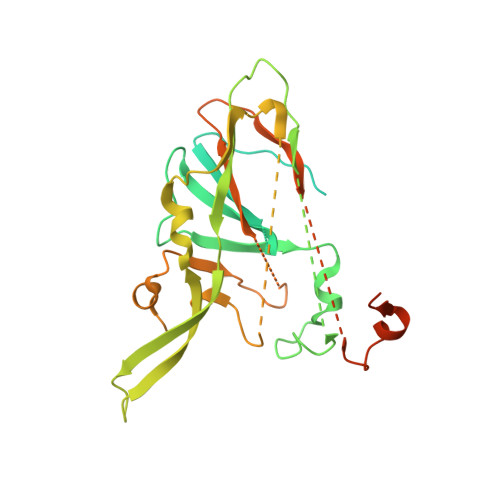Structural Dynamics of Nonenveloped Virus Disassembly Intermediates.
Azad, K., Banerjee, M.(2019) J Virol 93
- PubMed: 31484752
- DOI: https://doi.org/10.1128/JVI.01115-19
- Primary Citation of Related Structures:
6ITB, 6ITF - PubMed Abstract:
The stability of icosahedral viruses is crucial for protecting the viral genome during transit; however, successful infection requires eventual disassembly of the capsid. A comprehensive understanding of how stable, uniform icosahedrons disassemble remains elusive, mainly due to the complexities involved in isolating transient intermediates. We utilized incremental heating to systematically characterize the disassembly pathway of a model nonenveloped virus and identified an intriguing link between virus maturation and disassembly. Further, we isolated and characterized two intermediates by cryo-electron microscopy and three-dimensional reconstruction, without imposing icosahedral symmetry. The first intermediate displayed a series of major, asymmetric alterations, whereas the second showed that the act of genome release, through the 2-fold axis, is actually confined to a small section on the capsid. Our study thus presents a comprehensive structural analysis of nonenveloped virus disassembly and emphasizes the asymmetric nature of programmed conformational changes. IMPORTANCE Disassembly or uncoating of an icosahedral capsid is a crucial step during infection by nonenveloped viruses. However, the dynamic and transient nature of the disassembly process makes it challenging to isolate intermediates in a temporal, stepwise manner for structural characterization. Using controlled, incremental heating, we isolated two disassembly intermediates: "eluted particles" and "puffed particles" of an insect nodavirus, Flock House virus (FHV). Cryo-electron microscopy and three-dimensional reconstruction of the FHV disassembly intermediates indicated that disassembly-related conformational alterations are minimally global and largely local, leading to asymmetry in the particle and eventual genome release without complete disintegration of the icosahedron.
Organizational Affiliation:
Kusuma School of Biological Sciences, Indian Institute of Technology Delhi, New Delhi, India.














